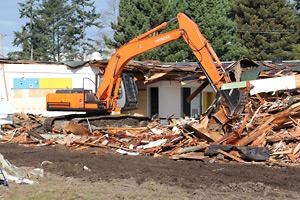School District 47’s demolition of Max Cameron Secondary School has a builder concerned over lack of salvaging materials from the building.
CaroleAnn Leishman, a project manager with Agius Builders Ltd., said it is a shame the district couldn’t have done more to salvage materials from the school. Her office sits directly above the demolition site and from her front-row view Leishman saw a considerable amount of wood, equipment and hardware that could have been reused being torn out and prepared for the dump. Much of the material that was removed is of a quality hard to find and expensive to buy, such as clear fir framing lumber from old-growth trees.
Last year the school district signed on as a partner on the Sustainability Charter for the Powell River Region, a document which Leishman helped to develop. The charter was adopted by City of Powell River council August, 2010. One of the mandates of the charter revolves around managing resources, a category which Leishman believes should encompass reusing materials. It seems to Leishman that the bare minimum of recycling, and only that which is mandatory, has been done, meaning that metals are being separated along with concrete and gypsum.
Agius Builders entered a bid on the demolition work but Leishman said that is not behind her criticisms. The bid from Agius involved salvaging about 90 per cent of the materials but for nearly double the cost. Leishman said they knew they would not get the contract and wishes instead extensive salvation had been included in the tender so that it would have happened regardless of who ended up with the job.
“This could have been a good opportunity to show that you’re signing something and you’re actually walking the talk,” said Leishman. “They shouldn’t have even had the opportunity for a low bid, crunch and munch to come in. Everybody should have been looking at it more from a salvage perspective.”
District secretary treasurer Steve Hopkins said the demolition company attempted to salvage the glulam (glued laminated timber) beams in the school to reuse. The ones from the old band room were salvageable but the others were not due to lead paint on them. The cost to refinish the beams safely did not fit into the budget. Hopkins didn’t know the specifics of what the demolition company salvaged but did say no wood or building materials were saved for reuse.
The price for the salvage bid came in at nearly double the bid the district ended up going with, making it financially unfeasible. All of the money comes from the district and the additional $400,000 that it would have cost them to salvage the materials would have been money that could have been used for other projects, such as building maintenance and upgrades at other schools.
“The money we get is at our discretion on how we spend it,” said Hopkins. “That would have been $400,000 that would go into vacant property. What we’re looking at is what can we do at other schools?”
Few incentives come from the ministry of education to incorporate salvaging into demolition projects, according to Hopkins. General green building initiatives exist, but in terms of demolition the cost difference is just too much to cover. The board did take the charter into account as a lens through which to guide the project but in the end the difference in cost for a salvage demolition determined the decision.



